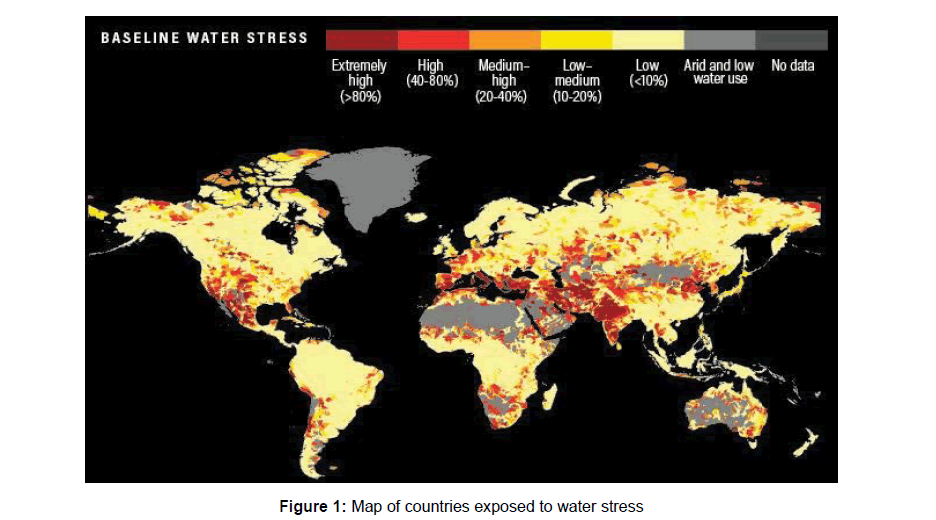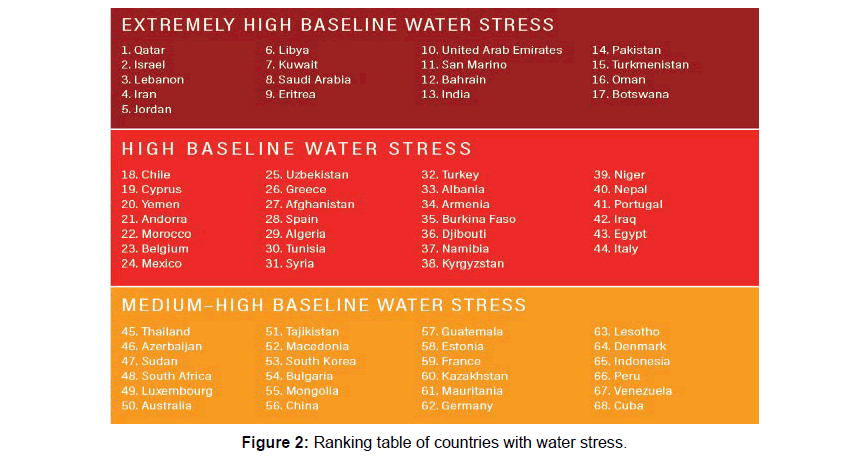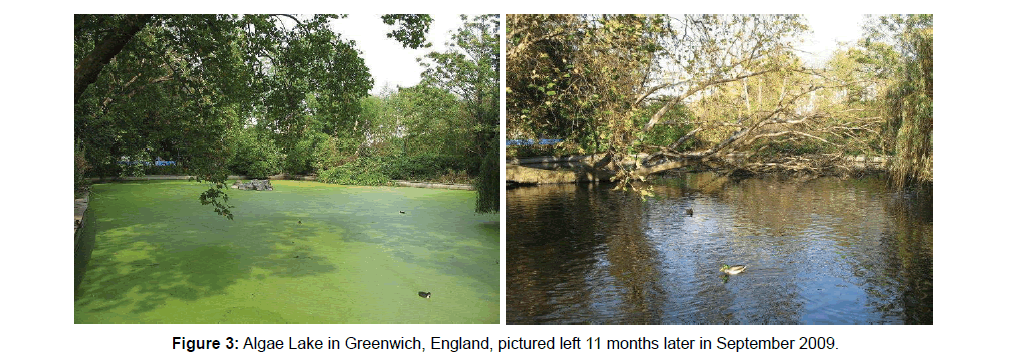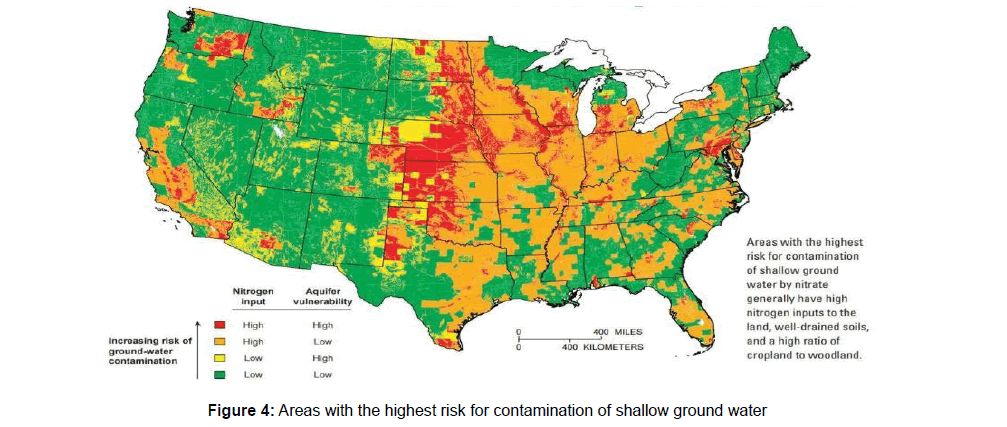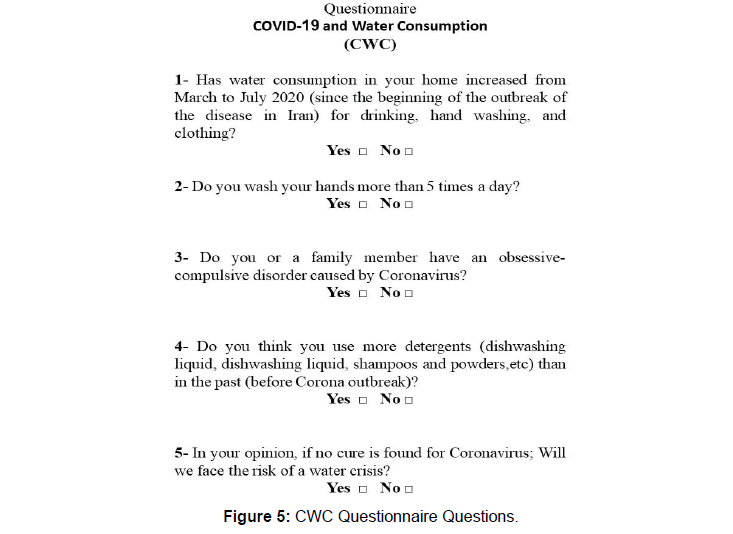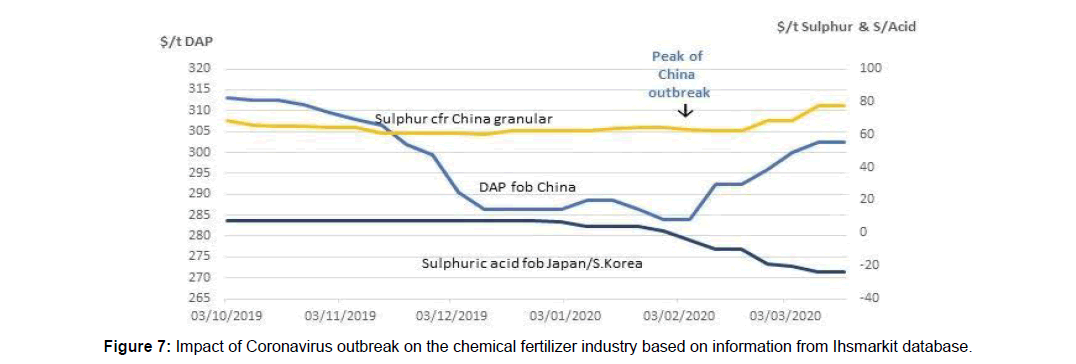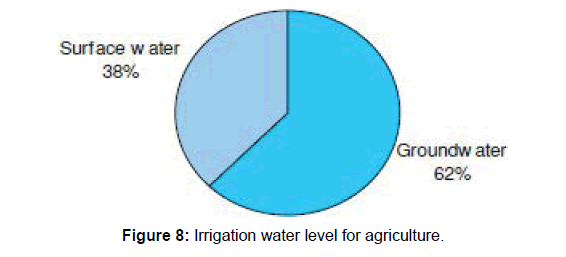The Impacts of the COVID-19 Crisis on Water and Soil Safety and Health with Emphasis on Iran Situation
Received: 07-Sep-2020 / Accepted Date: 20-Mar-2021 / Published Date: 27-Mar-2021 DOI: 10.4172/2155-9910.1000302
Abstract
Coronavirus, suddenly and gradually spread throughout the world. Although the adverse economic and social effects of the Coronavirus significantly increase the negative point of the disease, it also had a positive aspect, and that was the return of nature to its original place. Water is one of the most critical environmental factors which are highly polluted by human activities. Water has also a direct effect on soil pollution. Excessive use of chemical fertilizers on farms, discharges of sewage and industrial effluents into the seas, acid rain, and oil pollution are among the factors that pollute water and soil; in this way, Corona disease seems to affect the quality of water and soil by reducing these activities. Today, providing quality water and preventing its shortage crisis is one of the biggest problems for governments.
Keywords: Coronavirus; Water; COVID-19, Coronavirus, Water pollution, Soil health, Quality
Abstract
Coronavirus, suddenly and gradually spread throughout the world. Although the adverse economic and social effects of the Coronavirus significantly increase the negative point of the disease, it also had a positive aspect, and that was the return of nature to its original place. Water is one of the most critical environmental factors which is highly polluted by human activities. Water has also a direct effect on soil pollution. Excessive use of chemical fertilizers on farms, discharges of sewage and industrial effluents into the seas, acid rain, and oil pollution are among the factors that pollute water and soil; in this way, Corona disease seems to affect the quality of water and soil by reducing these activities. Today, providing quality water and preventing its shortage crisis is one of the biggest problems for governments. Although many studies have shown that measuring water quality parameters of water quality index during the disease period shows an improvement in water quality, Coronavirus can be dangerous for water sources in both direct and indirect forms: 1- By contaminating water with virus 2- Excessive standard water consumption to deal with the spread of disease. In Iran, due to the outbreak of the disease with hot weather, water consumption increased by about 40% compared to previous years. Therefore, endangering water security and creating a water shortage crisis caused by the disease can be more dangerous than direct contamination of water with the virus. It seems that if the current trend of water consumption continues and a pattern for standard water consumption in the Corona period is not established, there is a risk of water shortage in the future. Of course, this situation can happen to many countries in the world, especially Asian countries.
Keywords
COVID-19; Coronavirus; Water pollution; Soil health; Quality
Introduction
In the past century, there have been several pandemics. Within the context of global health, these pandemics have often been viewed from the lens of determinants such as population, poverty, and pollution. With an ever-changing world and the COVID-19 epidemic, the current global determinants of public health need to be expanded. To date, more than 26 million people worldwide been infected with the virus. According to the Iranian Ministry of Health Information, the corona infected more than 378000 people in Iran.
The outbreak of COVID-19 has caused unprecedented events worldwide, from macroeconomic problems to minimal psychological and social issues. The impact of the Corona crisis was such that it affected almost all aspects of human life, and various studies are now being conducted on its economic, social, and political effects. Zarei and Kaviani Rad examined the economic effects of the Corona crisis on the agricultural sector. Fard and Saffarinia presented research on aspects of mental health at the time of disease outbreak [1]. Despite the harmful economic and social consequences, Corona quarantine restrictions have been accompanied by good developments in countries such as reducing air pollution, improving environmental conditions, wildlife, and natural resources. It can be said that the only positive effect of Coronavirus was the temporary maintenance of ecological indicators at the desired level. Reducing air pollution, noise pollution and clean water were consequences that may be rare in the post-Corona period.
To date, research has been conducted on water contamination with the Coronavirus. For example, La Rosa investigated the possible presence of the Coronavirus in the water. Farm [2-4] studied the risk of transmitting COVID-19 through sewage. Quantifying the status of pollution during the lockdown period is an essential task for researchers to understand the impact of the COVID-19 spread on the environment in the short and long-term.
Water security
Water and soil health are among the ecological indicators on which the lives of humans, plants, and other living things are highly dependent [5]. Supplying the necessary amount of water and maintaining optimal quality is one of the most pressing challenges for human beings today.
More than a billion people do not have access to safe water, and well over 2 billion people live without adequate sanitation, at any given time, more than half of the developing world’s population is suffering from one or more of the primary diseases associated with unsafe water and poor sanitation. For children, the chances of survival dwindle in the absence of these essentials. Every day, 6,000 children die of waterrelated diseases. Young children are the first to get sick and die from waterborne and sanitation-related illnesses including diarrheal diseases and malaria [6].
Freshwater is vital for practically every aspect of the lives of humans, animals, environment, and ecosystems [7-10]. It can be the difference between life and death, and between bounty and poverty. Water planning and management continue to be challenging, according to Bloomberg database, approximately 1.8 billion people in 17 countries are in crisis and are likely to face severe water shortages in the coming years (Figure 1) [5].
Through new hydrological models, the WRI (World Resources Institute) [11] found that global water consumption had doubled since 1960 due to increasing demand and showed no signs of slowing down. Water stress poses severe threats to human life, livelihood, and trade stability. Twelve of the 17 countries with water stress are in the Middle East and North Africa (Figure 2).
The World Bank estimates that these regions will suffer the most economic losses in terms of water scarcity and its challenges, accounting for 6 to 14% of GDP by 2050. NITI Aayog says India is suffering from the worst water crisis in its history and the lives of millions are at stake. India ranks 13th in water. Although China ranks sixth in the world in total water resources (2.8 trillion m3), the annual per capita renewable freshwater availability is only 2300 m3, or 25% of the world's average. According to researches, China will face a water shortage crisis in the future [6,12,13].
Water pollution
Elemental pollution is one of the most common and costly water environmental problems in the United States, its caused by an increase in nitrogen and phosphorus in water and causes a harmful phenomenon called algal blooms. Too much nitrogen and phosphorus into the environment can pollute many rivers, lakes, bays, and coastal streams, endangering the health of the environment and humans) [7, 14-17]. By blocking the path of sunlight, algae harm aquatic life and can create areas without oxygen or with low oxygen in the water, known as dead zones. So far, more than 166 dead zones have been recorded in US waters. In addition to damaging small fish and aquatic animals, the dead areas also harm larger animals such as turtles, dolphins, and birds. The gulf of Mexico dead zone is the largest area in the United States, measuring 5840 square miles in 2013 [8].
The study by Zhang et al. [18] in northwest China shows that the comprehensive water quality index (CWQI) indicates that groundwater in the study area is severely polluted by TH, TSD, SO42-, Cl- and NO3- [19-21]. Also, Carman et al. [9] announced that nitrogen is the main contaminant causing degradation of water quality in the temperate coastal waters of Massachusetts (USA). The most important sources of coastal pollution are ship waste disposal, discharge of water, and petroleum products from vessels and sewage from industries [10,22].
Various factors such as the entry of human, agricultural, and industrial wastewaters into water resources and the increase of coastal pollution, which lead to the rise in seawater temperature. Increased greenhouse gas emissions, iron-rich dust, hydrological factors, and massive changes in the global climate, the transfer of non-native species through the water balance of ships, and other unknown factors are active factors in the occurrence of algal blooms [11, 23-25]. Much research has been done on algal blooms in Iran. Manaffar and Ghorbani reported that algal blooms in the northwest of Lake Urmia could be due to nitrogen and phosphorus pollution due to the entry of agricultural effluents. Rafiee et al. considered human factors to be effective in the infection of Zivar Lake (Kurdistan) with heavy metals.
More than 100,000 miles of rivers and streams, about 2.5 million acres of lakes and ponds, and more than 800 square miles of bays and estuaries in the United States are contaminated with nitrogen and phosphorus (EPA report, c). Figure 3 [26-30] shows an example of algal bloom in a lake. Elemental pollution is also so significant off the coast of the United States that, according to a 2009 EPA report, about twothirds of coastal areas have been affected. Bays and estuaries are often more vulnerable to elemental pollution because they are shallow and Wetlands are also involved in the tourism industry, fisheries and other occupations are severely affected by elemental and algal pollution. Wetlands absorb carbon and other pollutants and are therefore useful in reducing air pollution and global warming and are therefore known as the kidneys of the earth. The worrying point is that wetlands are disappearing three times faster than forests due to human activities and global warming [31-35]. Governments spend billions of dollars a year to minimize the effects of elemental pollution [31] because the cost for nitrate removal systems is very high. This type of pollution can cause billions of dollars in damage to tourism and damage buildings and other structures, especially those made of marble and limestone. Besides, the fisheries industry is estimated to lose tens of millions of dollars annually, and the value of coastal properties will decline if coastal waters are polluted [36].
Much of the Nation uses groundwater at its primary source of water for many needs, from drinking water and other home uses to irrigation to public uses, such as supplying water to parks. Of course, geology and the factors that affect the availability of groundwater vary greatly geographically. Still, many places, such as southern Georgia, have aquifers that can supply a lot of freshwaters very near the land surface. Since nitrogen contamination is more of a problem in shallow aquifers, it is worthwhile to be aware of what aquifers in the United States would be more at risk for nitrogen contamination. Developed for a USGS study, the map shows those areas with the highest risk for contamination of shallow groundwater by nitrate (Figure 4) [37,38]. Generally, aquifer vulnerability is represented by soil-drainage characteristics, the ease with which water and chemicals can seep to groundwater and the extent to which woodlands are interspersed with cropland [39]. Use of the risk map to identify and prioritize contamination at a more detailed level than presented here is not advised because local variations in land use, irrigation practices, aquifer type, and rainfall can result in nitrate concentrations that do not conform to risk patterns shown at the national scale [40,41].
Coronavirus has improved water quality in some parts of the world by reducing industrial activity, tourism, and maritime trade [42]. Although no research has been done on the effects of the disease on reducing algal pollution, it is predicted that by reducing the entry of pollutants through acid rain and industry, the rate of algal blooms in seas, lakes, and wetlands will decrease [44-49]. The water quality of all the principal rivers of India has been improved due to the shutdown of industries. Because the industries were closed down after lockdown 1, Lockdown 2 and Lockdown 3 in India and the most of the industrial effluent, which were discharged in these rivers, were also stopped [12, 50]. The mean value of DO was (N6 mg/l), Biological Oxygen Demand (BOD (b2 mg/l), and Total Coliform 5000 per100 ml), and pH ranged from 6.5 to 8.5. However, in this study, the indirect effects of the illness on water resources will be investigated.
Climate and water security situation in Iran
The climate of the Islamic Republic of Iran is one of the great extremes due to its geographic location and varied topography. The summer is sweltering, with temperatures in the interior rising possibly higher than anywhere else in the world; indeed, over 55°C has been recorded. In winter, however, the high altitude of much of the country and its continental situation result in far lower temperatures than one would expect to find in a country in such low latitudes.
Minus temperatures of -30°C can be recorded in the northwest and -20°C is standard in many places. Annual rainfall ranges from less than 50 mm in the deserts to 2 275 mm in Rasht near the Caspian Sea. The average yearly rainfall is 228 mm and approximately 90 percent of the country is arid or semi-arid. About 23 percent of the rain falls in spring, 4 percent in summer, 23 percent in autumn and 50 percent in winter [51].
According to the table in Figure 5, Iran is ranked fourth in the water stress ranking. Iran's total renewable water resources in 2017 were calculated at 137 billion cubic meters per year and for each person 1,688 cubic meters per year [52,54]. The Worldometers database reported in 2015 that 2,982,704 people, equivalent to 3.8% of the Iranian population, not have access to safe drinking water. Salami and T. Rikandeh, using the water poverty index, they assessed the water security situation in the provinces of Iran. According to this index, Sistan and Baluchistan, Qom, Kerman, Hormozgan and Golestan regions with severe water insecurity and Tehran and Gilan regions also face poor water security.
Materials And Methods
The information in this article is based on reports from organizations, surveys, and other essays. To further investigate the impact of the Corona crisis on water consumption, a questionnaire with five questions was designed, and a study of 250 people was conducted. Each person was a representative of a family, and thus more than 700 people were indirectly assessed. Questionnaire completion was often done by participants in absentia and online and the results were evaluated manually [55]. The questions in this questionnaire, abbreviated as CWC (Table 1), are shown in Figure 5.
| Answers to question | Yes | No |
|---|---|---|
| 1 | 196 | 54 |
| 2 | 196 | 54 |
| 3 | 107 | 143 |
| 4 | 200 | 50 |
| 5 | 198 | 52 |
Table 1: CWC survey results
Discussion
Impact of COVID-19 on water security
One of the most effective ways to deal with the disease is to wash your hands regularly with soap and water. Each time you wash your hands for 20 seconds, about 6 liters of water is consumed. According to the Research Center of the Islamic Consultative Assembly, water consumption in Iran during the Corona period has increased by about 40% compared to previous years [16,56].
In response to the first and second questions of the CWC questionnaire, 196 people, equivalent to 78.4% of the participants, believed that water consumption in their home increased during the illness and stated that they washed their hands more than five times a day and probably more than the standard level of water consumption. The rate of increase in water consumption according to the announcement of the Water and Sewerage Company in some cities of Iran is given in Table 2.
| City or Province | The rate of increase in consumption | Reference |
|---|---|---|
| Ilam | 40 | (Irna, 2020) (b) |
| Hamedan | 30 | (Tasnim News Agency, 2020) |
| Shiraz | 30 | (Irna, 2020) (c) |
| Semnan | 16 | (Mehrnews, 2020) (b) |
| Kermanshah | 20 | (Mehrnews, 2020) (c) |
| Gilan | 25 | (Ilna, 2020) (b) |
| Western Azerbaijan | 25 | (Borna News, 2020) |
| Southern Khorasan | 15 | (Fars News, 2020) |
| Zanjan | 15 | (Isna, 2020) (a) |
| Yazd | 20 | (Isna, 2020) (b) |
| Mashhad | 11 | (Qudsonline Newspaper, 2020) |
| Khuzestan | 17 | (Isna, 2020) (c) |
Table 2: Increase of water consumption in Iran's provinces (in percentage)
Significant decrease in rainfall of the current crop year (2019-2020) [57] in parts of South Zagros (up to 300 mm in some areas) along with a reduction in the share of snow compared to last year and forecast less than average rainfall for the autumn of the next crop year and even the possibility of its continuation until in winter, it can reduce the inflow of water to Karun from its main tributaries and cause water stress downstream and cause problems in water transfer projects from this basin. This situation will be exacerbated by rising temperatures forecast for the coming months, increased evapotranspiration, and increased urban water consumption due to the persistence of the Coronavirus, which requires intelligent management of water resources in the current and next crop years. Rainfall is expected to be below average in Iran, Turkey, Afghanistan, Tajikistan, southern Uzbekistan, and northern Pakistan [58]. The decrease in rainfall in Iran in autumn, especially in its western half, is quite apparent compared to normal. The country will be in relatively severe drought conditions, at least on a seasonal scale (Figure 6a). Such conditions, along with the decrease in rainfall in the provinces located in the southwest Zagros in the current crop year, increase in temperature and increase in urban water consumption to prevent the spread of COVID-19, can put the country's water resources in critical condition at the beginning of winter (Figure 6b) [13].
With the continuation of global warming and climate change, drought and groundwater shortages, and the process of combating Coronavirus, it is necessary to save more water. According to the information obtained from the beginning of the current water year to April 17, the amount of water inflow to the country's dams was 35.78 billion cubic meters, which is a decrease of 39% compared to the same period last year [14,59]. In response to the fifth question of the CWC questionnaire, 198 people, equivalent to 79.2% of the participants, believed that if no cure is found for the Corona and the water consumption situation continues in the current trend risk of a water shortage crisis.
COVID-19 was one of the main stressors for many people in the community. Lack of information about the disease and the announcement of the statistics of the patients has caused a kind of anxiety in some people and caused them to become obsessed with washing their hands and clothes more than usual. This situation will increase water consumption in the long run. According to the results of the third question of the CWC questionnaire, 107 participants, equivalent to 42.8%, stated that they or one of their family members became obsessed with washing due to the outbreak of Coronavirus. Alipour et al. also measured coronary anxiety in 308 Iranians [15,60-62].
However, there are opportunities to strengthen water security. The utilization of sewage and effluent resources can create new water resources. Oman, which ranks 16th in countries under water stress, collects 100% of its effluents and uses 78% of them again. About 84% of wastewater is treated in the GCC countries (Bahrain, Kuwait, Oman, Qatar, Saudi Arabia, and the United Arab Emirates), but only 44% is reused. The development of wastewater treatment systems in Iran should now be considered more than ever.
Positive effects of COVID-19 on water quality
Due to the closure of tourism, the amount of waste dumped into the Caspian Sea was sharply reduced. The quality of Caspian water on the coasts was much better due to less sewage, reduced activity of fishers, and reduced chemical effluents of factories. The rate of transportation in the Caspian Sea decreased by 40% and therefore, the volume of pollution load on the coasts of Mazandaran province fell sharply. The amount of world maritime trade decreased from 20 to 40 percent from January 20 to February 10, 2020, due to reduced commercial transportation through Chinese ports and the reduction of ship traffic in Asia.
The analysis of SPM (Suspended particulate matter) concentrations in Vembanad lake (India) based on the Landsat-8 OLI data revealed that the levels during the lockdown period were lower than those in the pre-lockdown period by 15.9% on average (-10.3% - 36.4%) and results suggested that pollution from industries and tourism had a severe impact on lake water quality. Similarly, the water quality in Venice, Italy, increased to the point where fish were seen.
One of the reasons for increasing water quality can be considered the reduction of chemical fertilizer use in agricultural lands. The Corona crisis on this sector was such that it limited and reduced the use of chemical fertilizers on farms. The chemical fertilizer sector in China, which is one of the most important producers of phosphate and sulfur, has been affected since the beginning of the outbreak due to production constraints. The decline in fertilizer production pushed up prices as large parts of the industry shut down in late January 2020 and limited supply and demand for chemical fertilizers (Figure 7). Transport and warehousing restrictions also posed severe challenges for the manufacturing of fertilizers.
Hubei Province plays a vital role in China's phosphate production; because this province accounts for 30% of China's total phosphate rock production. Due to the reduction in output to 30% of full capacity, the supply of phosphate fertilizers, sulfur and sulfuric acid, was faced with problems. Also, the reduced traffic caused severe bottlenecks in the sulfuric acid delivery chain and led to limited storage for many factories. In Brazil, long-distance transportation of fertilizers and crops was hampered by reliance on truck transport. Indian ports impose a 14- day quarantine law on ships carrying imported fertilizer, which affects the fertilizing farms. The impact of COVID-19 on Iran's fertilizer markets was such that the price of urea fertilizer doubled and became scarce so that farmers in Gilan, Zanjan, and Kermanshah provinces faced widespread problems in supplying urea fertilizer. Stopping the production of chemical fertilizers will have profound effects in the short term, and if this situation continues, we will probably see a sharp rise in fertilizer prices [16]. Reducing water pollution and algal blooms will only be possible by reducing the entry of chemical pollutants, and Corona disease can minimize water pollution by creating this limitation. Of course, this situation is not stable, and infection is likely to increase again in the post-Corona period as industrial and commercial activities intensify.
Long-term adverse effects of COVID-19 on water and soil quality
Washing hands with soap and water is one of the most important and easiest ways to prevent the spread of the disease (UNICEF, 2020). According to the Ministry of Industry and Trade of Iran, the production of detergents doubled during the period against Corona. Two hundred people, equivalent to 80% of the participants in the CWC questionnaire, answered yes to the fourth question and confirmed that they had increased the consumption of various detergents. This situation also has a negative side because soaps contain stable chemical compounds that can severely contaminate water and soil in the long run. One of the substances in detergents is NaOH, which according to the report of Mirelmi, causes a significant increase in soil adhesion. Imandel et al. by examining 316 wells in Tehran calculated the average concentration of detergents in groundwater between 0.1593 to 0.1163 mg/L. The presence of detergents in wastewater increases soil permeability, and microorganisms and even molecules that generally cannot pass through soil filters will pass through the pores of successive layers of soil in the presence of detergents. Detergents cause microbial contamination of water far from the ground (Department of the Environment Islamic Republic of Iran) [17]. The entry of wastewater containing detergents into surface water sources will lead to other environmental problems such as reduced dissolved oxygen, abundant foam production, poor views of landscapes and beaches and recreational areas, poisoning, and premature aging of rivers. Other adverse effects of these substances include reduced surface tension of water, defloration of colloids, and consequently, more use of coagulants in water treatment plants, emulsification of fats, and oils. Beneficial bacteria are also killed.
Because in Iran, significant part of the water needed for agricultural irrigation is supplied from underground sources (Figure 8), contamination of groundwater with detergents can be dangerous to the health of plants, living things, and ultimately humans [59]. Although the risks of water source contamination with the Coronavirus have not been addressed in this article, much research is needed (Figure 3).
Conclusion
Man has now realized the destructive effect it has on the planet. Reducing the presence of tourists in nature led to a reduction in waste and the return of tranquility to national parks. Coronavirus has allowed humans to think more about environmental protection. Protection of water resources is one of the most critical individuals, and social duties of human beings, and governments should try to prevent water wastage and pollution through management methods. It is recommended that a standard water consumption table be prepared against the Corona to avoid overconsumption. According to the CWC survey, 79.2% believed that water safety would be endangered if the outbreak continued.
It is also suggested that these measures be put on the list of governments:
• Construction of new wastewater treatment systems and technology upgrades.
• Strengthening and increasing the capacity of wastewater treatment plants.
• They are determining the standard limit of water consumption when washing hands and clothes during the Corona period.
• They are determining the standard limit of detergent consumption and publicity for optimal use.
• Public notification of possible water shortages in the future.
• Encourage subscribers who save water.
• Penalties for people who waste the water.
• Perform psychotherapy for people with obsessive-compulsive disorder.
• Repair and replacement of worn valves in public places and allocation of subsidies for replacement of pipes in homes.
• Use electronic valves to reduce water wastage.
Acknowledgement
The authors thank the webmasters for their cooperation in conducting the survey.
Acknowledgement
The authors thank the webmasters for their cooperation in conducting the survey.
References
- Alipour A, Ghadami A, Alipour Z, Abdullah Zadeh H (2020) Preliminary validation of the Corona Anxiety Scale (CDAS) in the Iranian Sample. Quart J Health Psy 8: 163-175.
- Fard AS, Saffarinia M (2020) Predicting mental health based on anxiety and social correlation due to COVID-19. Social Psy Res 36: 129-141
- Arora S, Bhaukhandi KD, Mishra KP (2020) Coronavirus lockdown helped the environment to bounce back. Sci Total Environ 742: 140573.
- Astani S, Agah H (2012) Algal bloom (red tide) and its environmental hazards, Sixth National Conference on Environmental Engineering in Tehran (Iran).
- Bazzi A (2014) Determining the level of heavy metal pollution in surface sediments of the Gulf of Chabahar. Iran. J. Health & Environ 8: 45-56.
- Bhowmick GD, Dhar D, Nath D, Ghangrekar MM, Banerjee R, et al. (2020) Coronavirus disease 2019 (COVID-19) outbreak: some serious consequences with urban and rural water cycle. npj Clean Water 3: 32.
- Borna News (2020) 25% increase in water consumption in West Azerbaijan due to Coronavirus.
- Carman MR, Bullard SG, Donnelly JP (2007) Water quality, nitrogen pollution, and ascidian diversity in coastal waters of southern Massachusetts, USA. J Exp Mar Bio Eco 342: 175-178.
- Cheng H, Hu Y, Zhao J (2009) Meeting China’s Water Shortage Crisis: Current Practices and Challenges. J Environ Sci Tech 43: 240–244.
- Climatological Research Institute of Iran (2020) Seasonal forecast of rainfall and country temperature.
- Dormido H (2019) These Countries Are the Most at Risk From a Water Crisis.
- Eckelkamp M (2020) Coronavirus: “Profound Impacts†On Fertilizer and Crop Protection.
- Fars News (2020) Corona increased drinking water consumption in South Khorasan by 15%.
- Guy J, Di Donato V (2020) Venice's canal water looks clearer as Coronavirus keeps visitors away.
- Ilna (b) (2020) 25% increase in water consumption in Gilan province following the outbreak of Coronavirus.
- Imandel K, Razeghi N, Samar P (1977) Tehran ground water pollution by detergents. J Water, Air & Soil pol 9: 19-122.
- Iran's Health Ministry (2020) The latest statistics of patients (COVID-19).
- Irna (a) (2020) Coronavirus ointment on the wounds of the Caspian Sea environment.
- Irna (b) (2020) Corona and concerns about increasing water consumption in Ilam.
- Irna (c) (2020) Corona and concerns about rising water consumption in Shiraz.
- Islamic Parliament Research Centre of Iran (2020) Impact of Corona on water and wastewater resources.
- Isna (a) (2020) 15% increase in water consumption in Zanjan due to COVID-19.
- Isna (c) (2020) Risk of drinking water supply problem in summer with increasing cultivation.
- Khubchandani J, R Jordan T, Yang Y, Tony (2020) Ebola, Zika, Corona, What Is Next for Our World?. Int J Environ Res Public Health 17: 3171.
- La Rosa G, Bonadonna L, Lucentini L (2020) Coronavirus in water environments: Occurrence, persistence and concentration methods - A scoping review. Water Res 179: 115899.
- Manaffar R, Ghorbani S (2015) Algal blooms in the west of Lake Urmia (freight station). J Cellular and Mol Res (Iranian Journal of Biology) 28:1-12.
- Mandal I, Pal S (2020) COVID-19 pandemic persuaded lockdown effects on the environment over stone quarrying and crushing areas. Sci Total Environ 732: 139281.
- Mehrnews (b) (2020) Corona increased water consumption in Semnan province by 16%.
- Mehrnews (c) (2020) Corona has increased water consumption in Kermanshah by 20%.
- Mirelmi E, Keramati M, Ghaemdost M, Khodabandeh M (2019) Evaluation of the effect of NaOH sodium hydroxide contamination on geotechnical parameters of Jajarm aluminum plant substrate soil (Case study). 4th Iranian National Conference on Geotechnical Engineering, Tehran, Iran Geotechnical Association - Shahid Beheshti University.
- Mumba M (2020) “Wetlands and Biodiversity†is the theme for World Wetlands Day 2020.
- P Yunus A, Masago Y, Hijioka Y (2020) COVID-19 and surface water quality: Improved lake water quality during the lockdown. J Sci total environ 31: 139012.
- Qudsonline Newspaper (2020) 11% increase in water consumption in Mashhad despite the absence of millions of passengers.
- Rafiee B, Hossein Panahi F, Shakiba Azad A, Sadeghifar M (2014) Distribution and origin of heavy metals (Ni, Co, Mn, Ti, V) in bed sediments of the Zarivar Lake. Appl sedimentology 3: 14-15.
- Salami HT, Rikandeh I ( 2019) Assessing the situation of water security in the provinces of Iran. J Agri Econ and Development 33:75-94
- Shahmansouri M, Roshani B (2005) Evaluation of Wastewater Treatment of Detergent Industry Using Coagulation Procession Pilot Scale. Sci Resh Journal of Shahid Sadoughi University of Medical Sciences 13:1
- Sivakumar B (2011) Water crisis: From conflict to cooperation- an overview. Hydrological Sciences J 56:4
- Tasnim News Agency (2020) Corona increased water consumption in Hamedan by 30%.
- UNICEF ( 2020) Everything you need to know about washing your hands to protect against Coronavirus (COVID- 19).
- USGS, Nitrogen and Water [Internet] Available from https://www.usgs.gov/special-topic/water-science- school/science/nitrogen-and-water?qt-science_center_objects=0#qt-science_center_objects
- Willem Hofste R, Reig P, Schleifer L ( 2019) 17 Countries, Home to One-Quarter of the World's Population, Face Extremely High Water Stress.
- Worldometers (2015) Iran Water. Available from https://www.worldometers.info/water/iran-water/ .
- Coronavirus Cases [Internet] Available from https://www.worldometers.info/coronavirus/
- Zarei M, Kaviani Rad A (2020) Covid-19, Challenges and Recommendations in Agriculture. J Botanical Res 2:1.
- Zhang Y, Wu J, Xu B (2018) Human health risk assessment of groundwater nitrogen pollution in Jinghui canal irrigation area of the loess region, northwest China. Environ Earth Sci 7: 273
Citation: Rad AK, Golkar F (2021) The Impacts of the Covid-19 Crisis on Water and Soil Safety and Health with Emphasis on Iran Situation. J Marine Sci Res Dev 11: 302. DOI: 10.4172/2155-9910.1000302
Copyright: © 2021 Rad AK, et al.s This is an open-access article distributed under the terms of the Creative Commons Attribution License, which permits unrestricted use, distribution, and reproduction in any medium, provided the original author and source are credited.
Select your language of interest to view the total content in your interested language
Share This Article
Recommended Journals
Open Access Journals
Article Tools
Article Usage
- Total views: 5042
- [From(publication date): 0-2021 - Dec 23, 2025]
- Breakdown by view type
- HTML page views: 4101
- PDF downloads: 941

